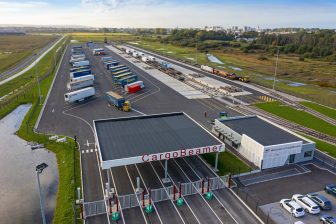
A price war could be on the doorstep of global trade and transport industry
The way that transport prices have developed so far in 2023 gives a significant benefit to sea shipping over intercontinental rail freight. Rail prices to transport a 40-foot high-cube container are currently three-four times higher than sea transport prices. The considerable cost gap has resulted from the combination of low consumer demand and increased capacity in sea vessels. However, the situation could intensify until the end of 2023 and result in a “price war,” according to Christian Roeloffs, CEO of Container xChange.
Container xChange is a platform that monitors global trade and transport developments closely, with a special focus on container pricing and movements. RailFreight.com had an exclusive talk with the company’s CEO, Christian Roeloffs, where he explained his views on the way that global trade and container prices develop and what to expect in the coming months.

Trade significantly negative
In general, there have been better years for trade than 2023. The year so far is characterised by a slow economic recovery, with China coming out of COVID-19 much slower than expected. “Add the inflation and technical recession in Europe, and you end up having a significant slowdown in consumer spending, which has a dampening effect on global trade and demand of transportation services,” underlines Roeloffs. In his view, “trade has been significantly negative over the past few quarters because demand has just sort of cratered.”
Too much free space
While demand drops, supply from the transport industry keeps growing. This creates another tricky puzzle that logistics companies need to solve. “Here you have the opposite picture,” says Roeloffs. “During COVID-19, prices were so high that everybody started ordering capacity. You now have about five million TEU too much in the market, and a significant oversupply of vessel capacity. Vessels typically take two or three years to be delivered. With so many orders at the height of COVID-19, so in 2021, these vessels are only being delivered in 2023-2024. Consequently, the fresh capacity entering the market creates an imbalance, and the only way to balance it is price,” he continues.
Besides vessel capacity, the transport market is also overflowing with available containers. “There is no issue with new containers built two-three years ago. They are in high demand, also because most of them were deployed by leasing companies into longer-term lease contracts. However, this is not the case with older containers. Depots, where containers are stored and repaired, overflow with empty boxes, and try to sell them out as fast as possible,” adds Roeloffs.
Rail the big loser?
The capacity developments mentioned above and the supply-demand imbalance force transporters to significantly reduce their prices for transport services and containers. “We have seen a significant drop in prices until the end of 2022 and then a bottoming out in the first half of this year. Overall, container prices have come down 50-70 per cent from their peak at the beginning of 2022,” highlights Roeloffs.
Understandably, the drastic pricing reductions in containers and transport services are dictated and implemented by the sea shipping industry primarily, affecting other transport sectors like rail. Lowered prices to fix the supply-demand imbalance have made sea shipping considerably cheaper than rail and helped it gain the upper hand in the market after some years of relative balance. “We are talking about rates that have come from 15.000-10.000 US dollars down to 1.200-1.300 US dollars, for example, from the Far East to Europe,” says Roeloffs.
On the rail side, prices are practically three to four times more expensive than at sea when transporting a 40-foot container. “Of course, the sanctions on Russia have played a significant role in impacting the Silk Road immensely,” narrates Roeloffs, who also claims that the pricing situation challenges Eurasian rail even more. “If I talk to our customers, rail freight between Asia and Europe has lost momentum over the past one and a half years since Russia decided to invade Ukraine,” he adds.
Indeed Silk Road rail is not in an advantageous position currently. However, as several experts have indicated, it is normal for the Eurasian rail transport industry to be subject to shifts, first because it is still developing and second because it has been through several crises in a very short time. In this sense, the main benefit that intercontinental rail has currently is its ability to match higher prices with better, faster and exclusive transport services.
What can the market expect?
As a closing remark, Roeloffs takes a look into the near future. When asked how he sees things developing until the end of 2023, he said he expects another freight rate decrease, reaching a level roughly equal to variable transportation costs, essentially making transporting a container unprofitable for shipping lines. Additionally, he noted that the market expects a significant influx of capacities, specifically vessel capacity, coming into the market in Q4.
“Currently, 30 per cent of the existing fleet is on order books, so there’s an additional 30 per cent that’s just waiting to come online once the ships are produced, and that will just significantly worsen the supply-demand imbalance and will force carriers to accept rates that are actually below variable costs, where it doesn’t really make sense to move containers anymore. However, they’ll still do it to keep existing volumes and not allow their competitors to increase their market share. So I would expect a price war coming, so to speak,” concludes Roeloffs.
Also read:



